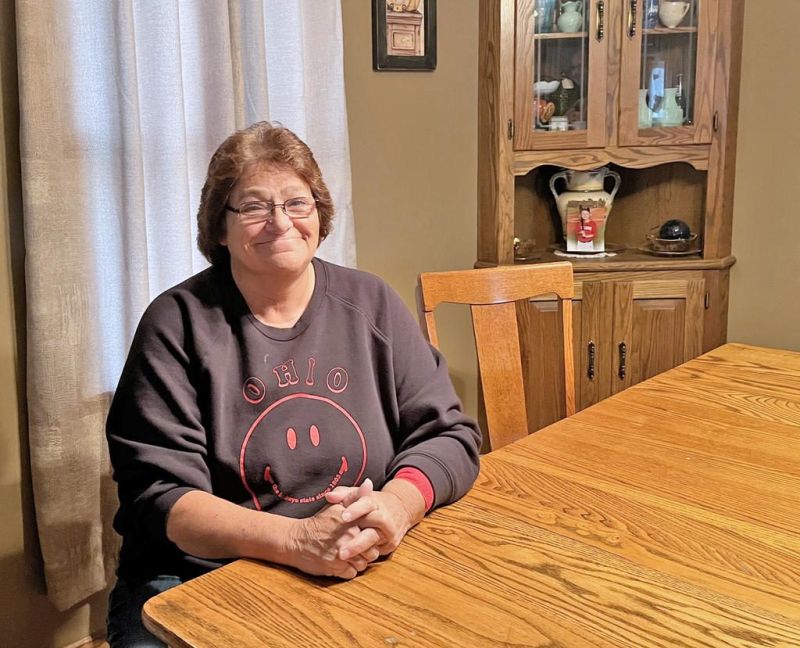The waiting game: Bolivar woman still in need of kidney
After 7 1/2 years of living on dialysis and waiting for a suitable kidney, it’s easy to understand why Tammy Seward gets emotional talking about it.
“It’s hell,” she said. “It’s just hard.”
She and her husband Rich wait each day, hoping to receive the call that will change their lives.
The 58-year-old Bolivar woman and her husband received two such calls from the Ohio State University Wexner Medical Center in 2017. The first time the kidney was not salvageable. The second time she received a kidney in the spring, but by November, her body was rejecting it, necessitating removal of the organ.
Rich Seward helps his wife with her daily at-home dialysis five days a week. Each treatment takes about three hours to complete. Undoubtedly, his years spent as an EMT help. Five times a week he must insert a 15-gauge flat needle into a fistula in his wife’s arm and start the machine that helps keep her alive.
A fistula is somewhat like a port, but it joins an artery and a vein together in the arm to make a blood vessel wide enough to accept the special needle.
To say Tammy Seward’s life has changed dramatically in the years since she entered end-stage renal disease would be an understatement. She has been hospitalized nine times for a total of 61 days, eight of them in the ICU. She also has undergone 10 surgeries and 11 other medical procedures.
“I lost my eyesight for a few months,” she said.
This was early when she was doing peritoneal dialysis at home. Her doctor said the process was not cleaning her blood enough, causing the temporary loss of sight.
The heavy cost
The Sewards say the cost of dialysis is currently $5,500 a day. At five times a week, that’s more than $1 million a year. Between Medicare and private insurance, almost all of the cost is covered.
Of course, there are other costs. “I’m only allowed 32 ounces of fluid a day,” Tammy Seward said. “That includes fluid from your food, like lettuce and watermelon.”
She also has to watch her daily intake of salt, potassium and phosphates.
Then there are the frequent headaches she gets from the dialysis, as well as blood-pressure fluctuations.
“I’d love to drink down a Pepsi right now, but I just can’t,” she said.
The couple also said they miss the freedom of being able to just get up and go. They can take vacations if they want to lug the huge dialysis machine around and arrange for supplies to be shipped to a hotel. No wonder they’ve never done it.
Tammy Seward said she also would love to go back to work as a cook at Tusky Valley Middle School. On disability since 2018, this year would have been her 20th year there.
How to help
The best way to help is to become a living donor. Living organs last longer after transplantation. The wait for the recipient is shorter, and surgery can be scheduled in advance. Almost anyone can become a donor as long as they are 18 years old and in good health.
According to the National Kidney Foundation, living donation does not change life expectancy, nor does it appear to increase the risk of kidney failure. People do not have to be a match to donate to Tammy Seward.
Through the Kidney Paired Donation Program, a donor can designate Tammy Seward as their recipient, have their kidney go to someone who is a match and Seward will go to the top of the national list.
“I want people to know they shouldn’t be afraid to donate a kidney,” Tammy Seward said. “Most people don’t have any problems with it, and it helps a lot of people.”
More than 90,000 people are currently on the national waiting list for kidneys, according to www.organdonor.gov. Information on the Kidney Paired Donation Program can be found at www.kidney-search.com.
One good match
The Sewards have been married for more than 38 years. They married when he was 21 and she was 19 but started dating when she was 15. They have three sons — Ben, Curtis and Matt — and a grandson, Dallas, who will turn 7 years old in December.
“I've been really lucky,” Tammy Seward said. “You’ve got to have your partner there with you, or you couldn’t go through this. He’s basically my nurse.”
Despite their circumstances, the two remain optimistic.
“It’s five days a week, but we pick the days and we pick the hours,” Rich Seward said. “Things could be better, but they could also be much worse. We put a positive spin on it because some people are living a much worse life.”
About his role, Rich Seward said, “These are things that caretakers do all the time. She would and has done the same for me. I can’t trade places with her because I couldn’t handle what she went through. She is the strongest and toughest person I know.”

